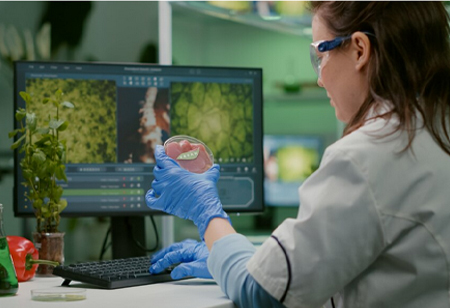Hridkamal Roy, Assistant Managing Editor, India Pharma Outlook

Two patents have been granted to research scholars of AU College of Pharmaceutical Sciences by the Indian Patent Office for exemplary work on formulation of herbal extracts for antidiabetic and hepatoprotective activity. Usage of herbal extracts for pharmaceutical formulations have grown over the years and that has contributed to the estimated growth of the industry for plant extracts to 61.5 Bn USD by 2027 exhibiting a CAGR of 12.2 percent according to a report published by Markets and Markets. Several herbal extraction technologies have emerged over the years that have added significant value to the industry. Specialized methods for extraction have come into being that are used for extraction of specified and targeted biochemical.
“Various novel techniques including supercritical fluid extraction, ultrasound-assisted extraction, microwave assisted extraction, and Soxhlet extraction have been developed for the extraction of nutraceuticals from the plant in order to decrease the extraction time, shorten the solvent consumption, enhance the quality of extracts and increase the extraction yields”, mentioned Archana R. Pawar, Department of Pharmacognosy, Pravara Rural College of Pharmacy.
Medicinal herbs and extracts are being increasingly used for the production of new pharmaceutical formulations and nutraceuticals as well. Let us now look into the various advanced technologies that are currently used for herbal extraction purposes.
This process involves extraction of bioactive compounds from plants and herbs with the use of supercritical fluids like carbon dioxide (CO2) as solvents. Under high pressure that goes over the critical point, the CO2 turns into a supercritical fluid thus exhibiting physical properties of both liquid and gaseous state. High diffusivity and low viscosity properties attained by the CO2 at the supercritical state allows smooth penetration into the plant body in order to extract the targeted compounds and in the process, no residues are left behind. The extraction process doe SFE can be easily adjusted according to pressure and temperature requirements that enable specific extraction of ingredients and also preserve their bioactivity. The pharmaceutical manufacturing industry makes wide use of this process because it is efficient and environmentally sustainable at the same time.
A notable example in this regard is Shiva Exports that offers a wide variety of Co2 extracted oils with trusted quality and years of expertise developed using Supercritical Fluid Extraction processes. The company’s process is designed in such a way that all the active ingredients of the botanicals remain intact in the essential oils extracted using CO2. These Oils come with a lot of purity and offer stability with a very long shelf life. Being the top manufacturers of Co2 Extracted Oils we use formulas and processes that are unique and modern.
In this process, the cell walls of plants and herbs are disrupted by means of ultrasonic waves that catalyze the release of bioactive compounds. The extraction efficiency for the UAE process is higher because the waves lead to cavitation which makes the micro-bubbles collapse within the solvent. Several advantages can be availed by usage of UAE process that include reduced consumption of the solvent, improved yields of extraction and shortened times for extraction as well. Moreover, ultrasound assisted extraction is an eco-friendly technology that can be implemented under atmospheric temperatures and minimize the degradation from heat sensitivity in the extracts.
To give an example, a company that has made a breakthrough in technology for Ultrasound-Assisted Extraction (UAE) is Industrial Sonomechanics (ISM). Focusing specifically on the challenging and high value extraction projects, the company has combined the ability to deliver high-intensity ultrasound with a scalable process flow (10 - 15 L/min flow rate) that comes as a unique feature in the industry. ISM's versatile and custom-configured equipment set can be applied to multiple bioactives, botanicals, microorganisms, pharmaceuticals, and many more related compounds.
Internal heat is generated in the plant material by means of microwaves in this process in order to facilitate the process of extraction. Here, the microwaves are able to induce rapid heat inside the plant particles thus disrupting cell structures. This initiates the release of the targeted biochemical from the herbs. Verey less energy is consumed in the MAE process and also provides high yields of extraction. As an extraction process, it is very scalable and is flexible enough to undergo automation as well.
In this regard, a company that specializes in the manufacturing of microwave assisted extraction (MAE) heating systems and technology is Ferrite Microwave Technologies (FMT). The company’s process of MAE offers a unique feature that improves the production capacity and quality of many biomaterials. The most examples of successfully tested MAE related products include plant protein extraction, oil from tar sands, chitin from seafood waste, and biofuel production.
“Earlier, herbal extracts were only used in the production of ayurvedic medicines and the market was also limited. Post COVID, a change has been observed in consumer awareness and behavior which increased the demand for herbal extracts in the market and also there has been an increase in the number of products as well”, mentioned Vikram Andrew Naharwar, MD, Amsar Botanical Extracts.
The emergence of these cutting edge technologies have been able to reshape the herbal extracts industry and also opened doors for creating herbal supplements, usage in the pharmaceutical industry and also create innovative nutraceuticals. Various other technologies are under research and will make way into the industry in the coming years.